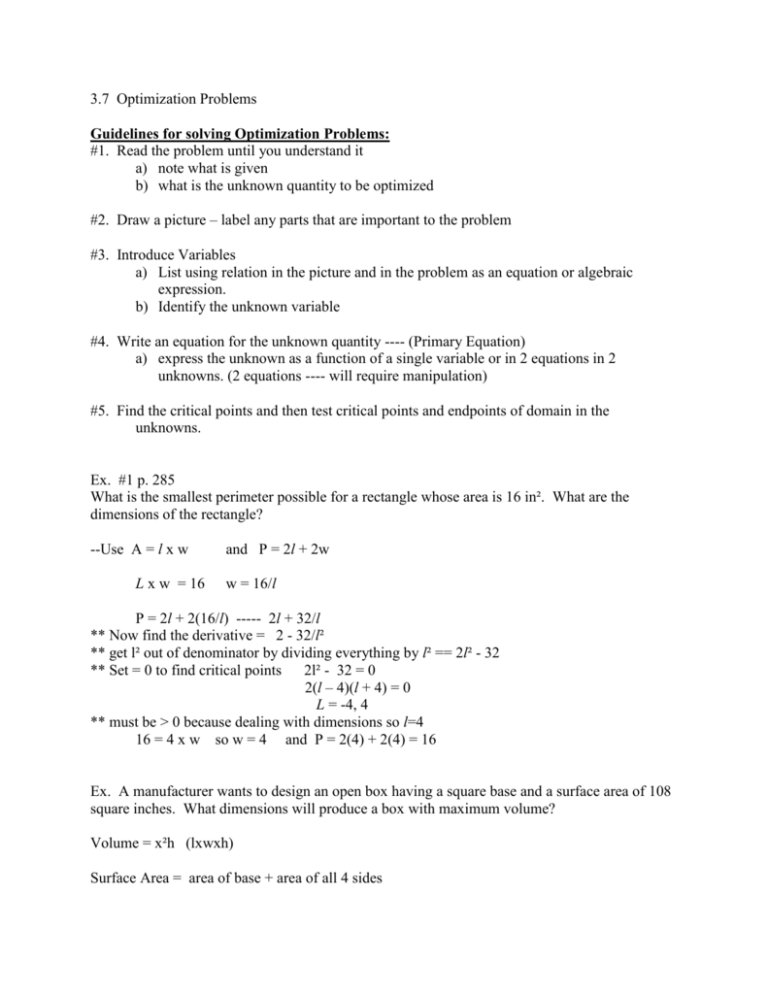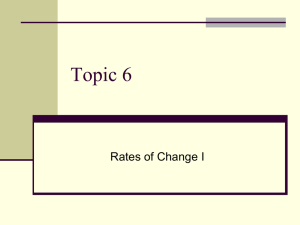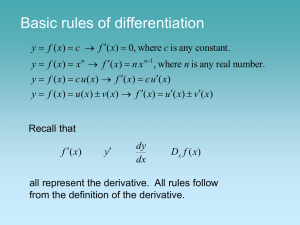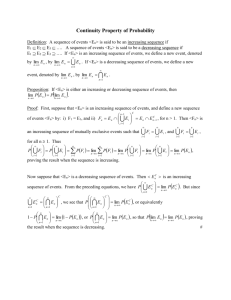Chapter 3 notes
advertisement

3.7 Optimization Problems Guidelines for solving Optimization Problems: #1. Read the problem until you understand it a) note what is given b) what is the unknown quantity to be optimized #2. Draw a picture – label any parts that are important to the problem #3. Introduce Variables a) List using relation in the picture and in the problem as an equation or algebraic expression. b) Identify the unknown variable #4. Write an equation for the unknown quantity ---- (Primary Equation) a) express the unknown as a function of a single variable or in 2 equations in 2 unknowns. (2 equations ---- will require manipulation) #5. Find the critical points and then test critical points and endpoints of domain in the unknowns. Ex. #1 p. 285 What is the smallest perimeter possible for a rectangle whose area is 16 in². What are the dimensions of the rectangle? --Use A = l x w L x w = 16 and P = 2l + 2w w = 16/l P = 2l + 2(16/l) ----- 2l + 32/l ** Now find the derivative = 2 - 32/l² ** get l² out of denominator by dividing everything by l² == 2l² - 32 ** Set = 0 to find critical points 2l² - 32 = 0 2(l – 4)(l + 4) = 0 L = -4, 4 ** must be > 0 because dealing with dimensions so l=4 16 = 4 x w so w = 4 and P = 2(4) + 2(4) = 16 Ex. A manufacturer wants to design an open box having a square base and a surface area of 108 square inches. What dimensions will produce a box with maximum volume? Volume = x²h (lxwxh) Surface Area = area of base + area of all 4 sides 108 = x² + 4xh Because volume is maximized we want to express V as a function of just 1 variable so solve for h: x² + 4xh = 108 h = (108 - x²) 4x V = x² (108-x²) 4x ** now plug h back into original equation = 108x² - x4 4x = 27x - x³ 4 Now to find maximum value of V – determine a feasible domain – where do the values of x make sense in this problem? **know V≥0 and that x can’t be - and that Area of base = x² is at most 108 So feasible Domain = 0≤x≤√108 **to maximize V - find critical numbers so differentiate with respect to x Dy/dx 27x - x³ = 27 – 3x² 4 4 ** now set =0 and find critical pts. 27 – 3x² = 0 4 x²=36 x = -6, 6 (only want +6) **Now evaluate endpoints and critical points V(0) = 0 (0,0) V(6) = 162 – 54 = 108 (6,108) ** so x = 6. h = 3 and x = 6 V(√108) = 0 (√108, 0) Economics Optimization: Marginal Revenue dr/dx Marginal Cost dc/dx Marginal Profit dp/dx r(x) = revenue for selling x items c(x) = cost of producing x items p(x) = r(x) – c(x) profit from producing and selling x items if p(x) = r(x) – c(x) has a max value it occurs at production level at which p′(x) = 0 ** at a production level yielding max profit – marginal revenue = marginal cost Ex #43. You offer a tour service that offers the following: *$200 per person if 50 people (the min. to book a tour) go on the tour * For each additional person, up to a max of 80 people total, the rate per person is reduced by $2 It costs $6000 (a fixed cost) plus $32 per person to conduct the tour. How many people does it take to maximize your profit? Let x = the # of people (50 + x) = the # of people over 50 (200 – 2x) = reduced rate for each person if over 50 book Cost = 32(50 + x) – 6000 P(x) = r(x) – c(x) so p(x) = (50+x)(200-2x)-32(50 + x) -6000 P(x) = -2x² + 68x + 2400 ** Now take derivative and set = 0 to find critical points -4x + 68 = 0 x = 17 So (50 + 17) would maximize profit = 67 people 4.7 Indeterminate Forms and L’Hopital’s Rule Suppose we are trying to analyze the behavior of the function f(x) = lnx x -1 ** although f is not defined at x=1, we need to know how f(x) behaves near 1 (in other words – we want to know the value of the limit) ** In computing the limit – we see that the Numerator and Denom. approach 0 and are not defined this leads to: Indeterminate Form (0/0 form) – occurs when continuous functions f(x) and g(x) are both 0 at x=a, so lim f(x) cannot be found by substituting x=a, it would result in 0/0 g(x) x--a **in our study of limits we found that it we used cancellation, rearrangement of Terms, or some other algebraic manipulations, it often led to indeterminate 0/0 Form. ** However, if we used the form lim f(x) – f(a) the long form of the derivative x–a x—a it would prevent getting the indeterminate form. This leads to: L’Hopital’s Rule (First Form) Suppose that f(a)=g(a) = 0, that f′(a) and g′(a) exist and that g′(a) ≠0 then Lim f(x) = f′(a) g′(a) ** treat as 2 separate functions x ---a g(x) (show graphical representation) Ex. a) lim 3x – sinx x x---0 b) lim √1 + x - 1 x—0 x ** sometimes, though, after differentiation, the new Numerator and Denominator both still = 0 at x=a, then we use the stronger form of L’Hopital’s Rule L’Hopital’s Rule (Stronger Form) Suppose that f(a) = g(a)=0 and that f and g are differentiable in the open interval, I, containing a and that g′(x)≠a on I if x≠a then Lim f(x) = lim f′(x) x—a g(x) x—a g′(x) **basically just keep deriving til no 0 in denomin. Ex. a) lim √1 + x -1 + x/2 x—0 x² b) lim x – sinx x—0 x³ **L’Hopital’s Rule does not apply when either the Numerator or Denominator has a finite nonzero limit --- Must be indeterminate form of 0/0 Ex. lim 1-cosx x—0 x + x² L’Hopital’s Rule with One Sided Limits: Ex. lim sin x + x—0 x² lim sin x x—0 x² Indeterminate Forms ∞/∞ - if in the form where both f(x)---∞/-∞ and g(x) --- ∞/-∞, then lim f′(x) may or may not exist provided that the limit on the right exists x—a g′(x) Ex. lim sec x x--π/2 1+tan x b) lim x- 2x² x--∞ 3x² + 5x c) lim ex x--∞ x² Indeterminate Form ∞∙0 If lim f(x) = 0 and lim g(x) = ∞/-∞ then it is not clear what the values of lim f(x)g(x) x—a x—a x—a if any, will be – there becomes a struggle between f and g. a) if f wins – then the answer = 0 b) if g wins – then the answer may be ∞ or -∞ c) **may be a compromise where the answer is a finite nonzero # ** You deal with this by writing f(x)g(x) as a quotient: fg = f or fg = g 1/g 1/f (put whichever = 0 in numerator) Ex. Lim (xsin 1 ) x--∞ x Steps: 1 evaluate f and g at x--∞ Step 2 Then derive each the n and d separately Step 3 Solve Indeterminate Difference Ex. Lim ( 1 - 1 ) x—0 sinx x if x—0+ then sin x—0+ and 1/sinx – 1/x = ∞ - ∞ if x—0- then sin x—0- and 1/sinx – 1/x = -∞- -∞=-∞+∞ Steps: to find out what happens to the limit – combine functions: So: 4.7 Newton’s Method – a technique to approximate the solution to an equation f(x) =0 ** It uses tangent lines in place of the graph of y=f(x) near the points where f is 0 GOAL: for estimating a solution of an equation f(x) = 0 is a) To produce a sequence of approximations that approach the solution --starts with an initial guess (x0) and improves the guess 1-step at a time. Refer to graph: Procedure for Newton’s Method: - let f(c)=0 where f is differentiable on an open interval Containing c, then to approximate c do the following: #1. Make an initial estimate, x0 that is close to c #2. Use the 1st approximation to get a 2nd, then use the 2nd to get a 3rd, and so on using: Xn+1 = xn - f(xn) if f′(xn) ≠0 f′(xn) Ex. f(x) = x²-2 we use x0 = 1 as initial guess (graph in calculator) a) f(x) =x² - 2 f′(x) = 2x so: using above formula: xn+1 = xn - xn² - 2 2xn = xn+1 = xn – xn + 1 2 xn X0=1 so plug in 1 1 - ½ + 1/1 = 1.5 X1 = 1.5 1.5 – .75 + (1/1.5) = 1.41667 X2 = 1.41667 = 1.414216 X3= 1.414216 ** if we keep carrying this procedure out you will see it converges To 1.4142…. where each recursion results in more decimals places Carried out, but with the same first 5 decimals – approaches a limit (we know this particular answer is √2 = 1.414213562 Purpose of Newton’s method – it is used to calculate roots b/c they converge so fast. Ex. Find the x-coordinate of point where curve y = x³ - x crosses horizontal line at y=1 Start by writing f(x) = x³ -x = 1 then solve by getting = to 0 Convergence of Newton’s Method: as in above examples, the approximation approaches a limit – the sequence x1, x2, x3,…xn is said to converge – therefore if the limit is c, then it can be shown that c must be a 0 of f. When Newton’s Method doesn’t yield a convergent sequence: #1. B/C Newton’s method involves division by f′(xn) – it is clear that the method will fail if the derivative is 0 for any xn in the sequence a) Correct this by = overcome it by choosing a different starting value of x #2 When successive approximations go back and forth between 2 values (iterative formula. Conditions for Convergence: │f(x)f′′(x)│ < 1 │[f′(x)]² │ Ex. f(x) = x²-2 f′(x) = 2x f′′(x) = 2 = │(x²-2)(2)│ = │ 1 - 1 │ │[2x]² │ │ 2 x² │ What about on interval (1,3) - just plug into above and see if <1 and it will indicate convergence. #3. When Newton’s method converges to a root, it may not be the root you have in mind. Fractal Basins and Newton’s Method a) finding roots by Newton’s method can be uncertain in the sense that for some equation --- the final outcome can be extremely sensitive to the starting values location Ex. f(x) = 4x4 – 4x² (look at figure 4.52 in book p. 304 there are 3 roots you can see from graph since there are so many roots you have “basins of attraction” Fractal Basins – when each root has infinitely many “basins’ of attraction in the complex plane – each basin has a boundary where complicated patterns repeat without end under successive manipulations. Exercise #6 Use Newton’s method to find the negative fourth root of by solving the equation x4 – 2 = 0. Start with x0 = 1 and find x2







